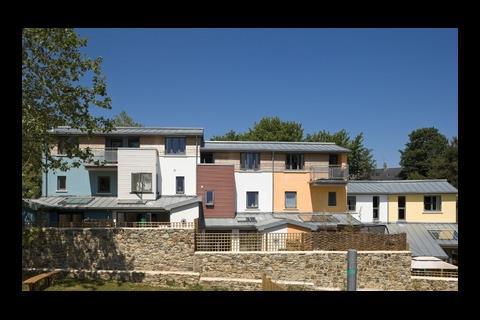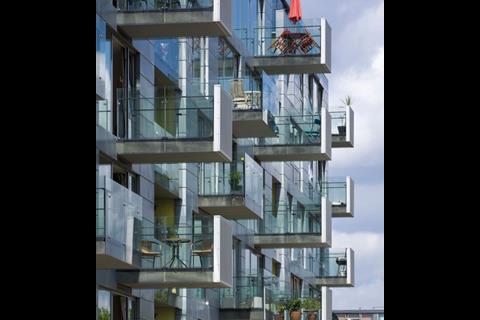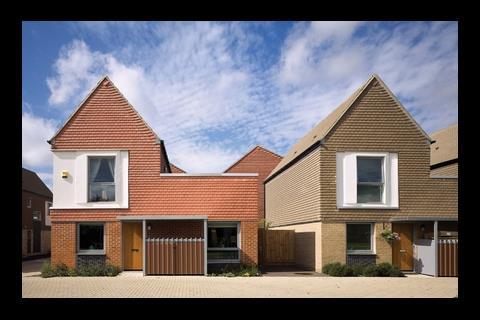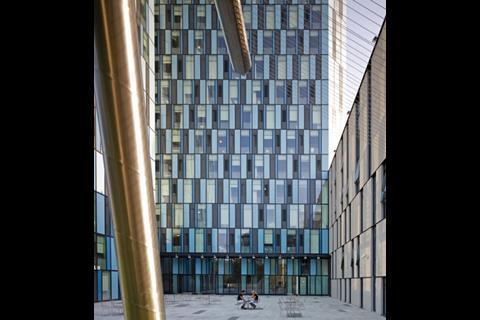This year’s Housing Design Awards are a tribute to affordable family homes that radiate local character, such as this modern take on the traditional Devon terrace
The presentation of the Housing Design Awards yesterday by Ian Austin, the communities department’s minister for the West Midlands, could not have been more timely. Less than three weeks ago, prime minister Gordon Brown offered an extra £250m, on top of the £100m pledged in the April Budget, for local authorities to develop 3,000 homes. But what sort of homes?
Affordable family housing radiating local character and the inventive use of space were the key notes of this year’s awards. And the overall winner embodied this spirit: a unique creation in Devon by the local authority, a local architect and the local community.
Overall winner: South Gate, Totnes, Devon
Architect: Harrison Sutton Partnership
Developer: South Hams council, Midas Homes, Sovereign Housing
Contractor: Midas Homes
A bafflingly intricate housing scheme in Totnes, Devon, has scooped the top Housing Design Award this year. What it may lack in visual cohesion, it more than makes up for by ingeniously packing 53 homes into four tiny, steeply sloping urban sites.
The main design challenge was how to pack so many family homes on to two pairs of tiny, sloping sites. Harrison Sutton’s solution was four rows of houses that step gaily up the slopes in a contemporary reinterpretation of traditional Devon terraces. In one, rows of two-storey houses and duplexes sit back to back, the duplexes jacked up above garages to gain unobstructed southerly views from the third floor.
Another terrace (shown left) flaunts rendered walls in several pastel colours, timber boarding, zinc roofs and garden walls of natural stone recycled from a former cattle market on the site.
Although the results are impressive, the process of development is the real star. The scheme was initiated by South Hams council to provide affordable homes for local people priced out of the market by rich second-homers swooping down on the Devon Riviera nearby. But its first proposal was rejected by the local community, which set up its own group called Design Our Space to look at the issue. Within three months, the group had persuaded the council to withdraw its scheme and instead work with it and the local architect. Together they drew up a higher density scheme that could fit in more affordable homes and a larger proportion of family homes.
The council went on to form a partnership with Sovereign Housing and local housebuilder Midas Homes to fund and develop the housing, in which 37 social rented and shared-equity homes would be cross-subsidised by 26 homes for sale. South Hams then directly funded the special landscaping features and the enhanced specification needed to attain Ecohomes “excellent” standard for sustainability. Local co-operation has led to a solution where all groups are satisfied, not least young residents in desperate need of a home.
Completed scheme winner: Angel Waterside, London N1
Architect: Pollard Thomas Edwards Architects
Developer and contractor: joint ventures between Pollard Thomas Edwards and Groveworld
This elegant eight-storey apartment block in inner London opens up canal frontage to residents for the first time by stretching out behind a new waterside park. Inside the block, the 85 mixed-tenure apartments are not reached by a long central corridor but by four separate lift cores. This mould-breaking ruse enables the larger flats to stretch right through from front to back, and in doing so offers canal views to a larger proportion of flats.
The whole scheme was conceived, designed, developed and built by Pollard Thomas Edwards Architects, partly in a joint venture with small housebuilder Groveworld.
Completed scheme winner: Hereward Hall, March, Cambridgeshire
Architect: Proctor and Matthews
Developer: Home Group
Contractor: Inspace
Hereward Hall stands in a remote village in the Cambridgeshire fens and draws on local building styles. Visually, the development is a modern reinterpretation of traditional Fenland cottages, but behind the clay bricks and tiles in three complementary colours stand thoroughly modern insitu concrete frames. In fact, the scheme of 35 mixed-tenure houses is an eco-experiment dubbed SmartLIFE that was backed by BRE to compare different techniques of sustainable housebuilding.
In addition to the development’s green credentials, the award judges were most impressed by how the houses were sensitively grouped at high density of 50 homes per hectare around intimate mews with shared paved surfaces
Future Proof award: Clay Field, Suffolk
Architect: Riches Hawley Mikhail Architects
Developer: Orwell Housing Association
Contractor: O Seaman & Son
This scheme of 26 socially rented houses in rural Suffolk attains Ecohomes “excellent” standard with a unique local spin on sustainability. Its design by fledgling practice Riches Hawley Mikhail Architects was chosen in an architectural competition. Sustainable features include organic insulation of hemp sprayed with lime, heat extraction of exhaust air and a biomass boiler for community heating.
The oddly asymmetrical houses have been cleverly angled so as not to obstruct low-angled winter sunshine. And in the three-storey houses, low roof ridges in combination with sunken ground floors freed staircases from having to be made fire-resistant – obligatory when roof ridges rise above a certain height.
Must See award: KX200
Architect: Allford Hall Monaghan Morris
Developer: First Base and The Blackstone Group
Contractor: Bovis Lend Lease
Two drab 14-storey towers at London’s King’s Cross have been transformed into a vibrant mixed-use complex. One tower now contains 846 student rooms and the other 48 private rental flats. Affordable housing, offices, shops and restaurants have all been packed into a five-storey podium.
Judges felt that the affordable housing had been too tightly hemmed into the podium but were impressed with the recladding in bright blue panels and the double-height entrance lobby.































No comments yet